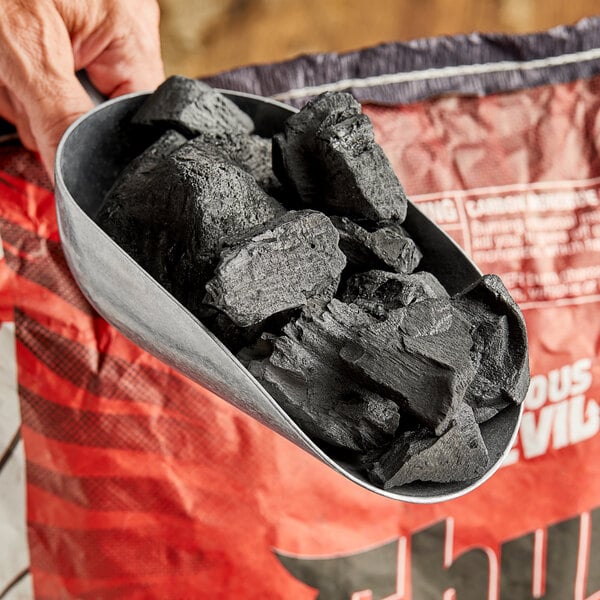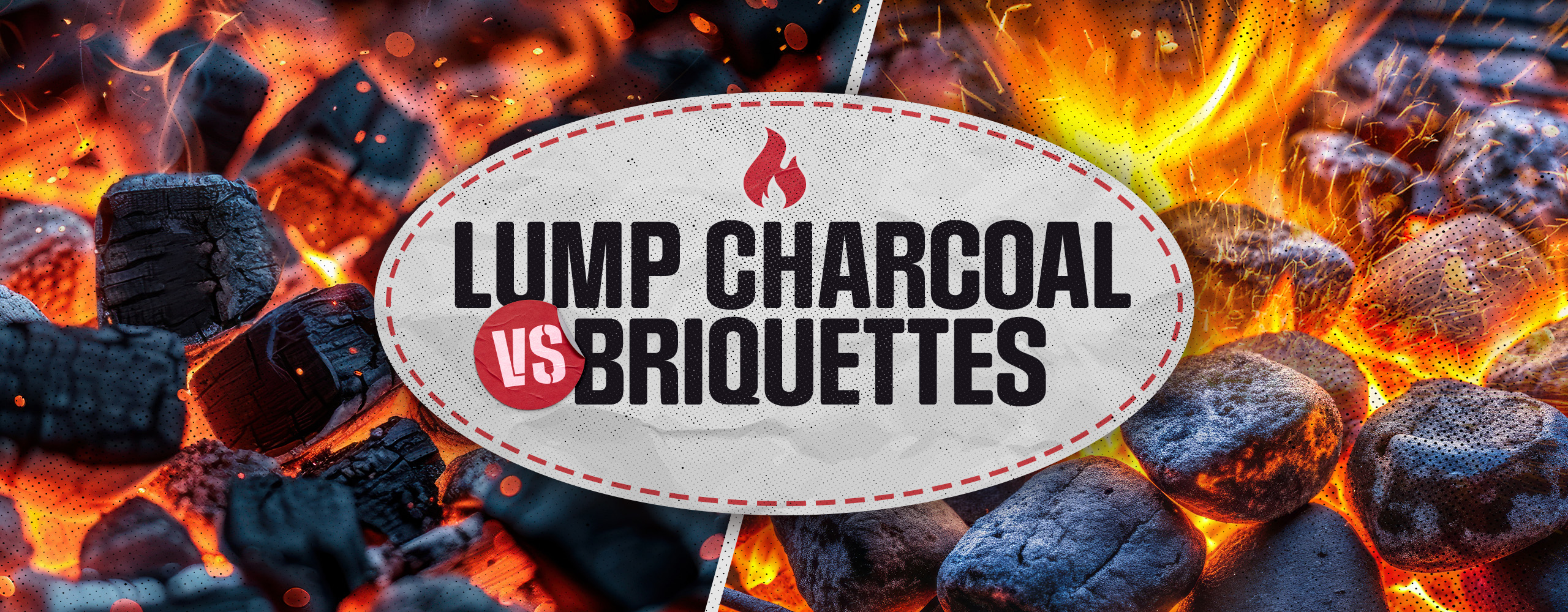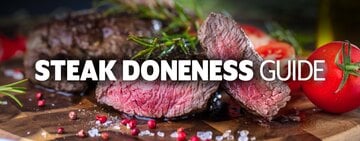What's the Difference Between Lump Charcoal and Briquettes?
Last updated on Jan 21, 2025Katie McCaslinLump charcoal and briquettes are popular for smoking meats or grilling entrees. The difference between briquettes and lump charcoal is their composition, burn time, heat consistency, and flavor influence. Briquettes burn longer than their counterpart and contain additives that affect flavor, while lump charcoal burns hot and fast with no added chemicals. Use this article to learn which charcoal matches your preferred qualities such as final flavor, heat control, and overall cooking equipment performance.
What Is Lump Charcoal?

Lump charcoal, made from pure carbonized wood, burns hotter and produces less ash than other fuel types, making it ideal for high-heat grilling and searing. It lights quickly and reaches cooking temperatures in 7 to 10 minutes. Its qualities give food a natural, smoky flavor, enhancing grilled meats. However, its irregular shape can make temperature control challenging, especially during long cooks. Despite this, lump charcoal remains a favorite among chefs and foodservice professionals seeking bold flavors and clean-burning fuel.
What Is the Best Lump Charcoal?
Finding the best lump charcoal depends on the wood type, size consistency, burn efficiency, and your grill or smoker. Quality brands often use premium hardwoods like oak, hickory, ash, or beech for superior flavor and performance. Some top options include charcoal sourced sustainably, ensuring high heat and minimal impurities during use. Look for lump charcoal with uniform pieces and minimal dust or debris for easier temperature control. Note that the added flavor from the charcoal depends on the type of hardwood in its makeup.
How to Light Lump Charcoal
Follow these simple steps to light lump charcoal properly:
- Prepare your grill or smoker: Arrange the lump charcoal in a pile or use a chimney starter to keep the coals contained and concentrated for easy ignition. Use a single-layered donut shape for slow cooks or multiple stacked layers for fast cooks.
- Choose your ignition method: Use a natural firestarter, electric starter, or match-lit charcoal to avoid chemical flavors from lighter fluid. Arrange fire starters between the charcoal to help it catch more quickly.
- Light the charcoal: Ignite your firestarter or use a long match to light the coals in multiple spots for an even burn. Make sure your damper and lid are open so air flow can assist with the lighting process.
- Wait for the coals to ash over: Allow the coals to burn until they are glowing red and covered in a light layer of gray ash, which indicates they’re ready for cooking.
- Spread the coals: Distribute the hot coals evenly across the grill or smoker to create consistent heat zones for cooking. At this point, you can shut the lid and partially close the bottom damper to keep the fire going.
Is Lump Charcoal Better than Briquettes?
Lump charcoal burns hotter than briquettes, lights quickly, and burns cleanly without additives. It produces minimal ash for easy cleanup, and it allows for easy temperature adjustments. However, the uneven shapes cause inconsistent heat distribution compared to briquettes. It also requires frequent refueling due to fast burn times.
What Are Briquettes?

Briquettes are uniform, compressed blocks of charcoal made from a mix of wood byproducts, binding agents, and sometimes additives to promote consistent burning. They burn longer and more steadily than lump charcoal, making them ideal for low-and-slow cooking. However, the additives in some briquettes can affect flavor, which may not appeal to those looking for a pure charcoal taste. Their affordability and reliability make briquettes a popular choice for foodservice establishments requiring precise heat control.
What Are the Best Charcoal Briquettes?
The best charcoal briquettes offer a clean burn with minimal additives that won’t interfere with food flavor. Look for high-quality brands that use natural binding agents and avoid excess chemicals. Premium briquettes, such as those made from hardwood or coconut shell byproducts, provide steady heat and longer burn times. Consistency in shape and size also helps maintain even temperatures for precise grilling and smoking.
How to Light Briquettes
Follow these steps to light charcoal briquettes effectively:
- Arrange your briquettes: Position briquettes in a pile in the grill or load them into a chimney starter for concentrated and efficient ignition.
- Choose your ignition method: Briquettes take longer to start than lump charcoal, so choose an ignition method that will help it catch more quickly. Use a firestarter, electric starter, or lighter fluid (if necessary) to ignite the briquettes evenly.
- Light the briquettes: Ignite your firestarter or apply a long match to the briquettes in several spots to ensure even burning. Add more paper or fire starters to assist with catching.
- Wait for the briquettes to ash over: Let the briquettes burn until they are glowing red and coated in a light layer of white ash, signaling they’re ready for cooking.
- Spread the briquettes: Distribute the hot briquettes across the grill to create even heat zones or maintain them in a pile for direct heat cooking.
Are Briquettes Better than Lump Charcoal?
Briquettes provide steady, long-lasting heat for controlled cooking with a consistent size and shape for predictable performance. It's also more affordable and widely available than lump charcoal. Though these qualities make it ideal for smoking and low-temperature cooking, briquettes take longer to light than lump charcoal and produce more ash. Moreover, they may include additives that affect the flavor and odor of your food.
Charcoal FAQ

If you're still wondering which type of charcoal to use, check out these frequently asked questions for more clarification.
What Is Charcoal?
Charcoal is a fuel source created by burning wood or other organic materials in a low-oxygen environment, leaving behind carbon-rich pieces. It provides a clean, consistent burn that makes it ideal for grilling and smoking meats. Charcoal comes in two primary forms - lump charcoal and briquettes - that offer different advantages in heat output, burn time, and flavor. While natural lump charcoal is comprised of hardwood, briquettes are made of hardwood char, coal, sodium nitrates, lime, and starch.
How Long Does Charcoal Burn?
Charcoal usually burns for 40 to 45 minutes on an open grill, but due to limited oxygen, it can burn for several hours in a closed smoker.
How Hot Does Charcoal Burn?
Charcoal burns at extremely high temperatures, reaching over 2000 degrees Fahrenheit. In cooking, charcoal typically burns at 500 degrees Fahrenheit and can reach up to 700 degrees Fahrenheit. Oxygen causes coals to burn hotter and faster, so adjust the oxygen level to control cooking heat.
What's the Difference Between Cooking with Charcoal vs Wood?
While wood provides distinct flavors and natural smoke for cooking, it burns unevenly and requires more monitoring. Charcoal, on the other hand, offers a more consistent heat source and cleaner burn, giving chefs greater control over grilling and smoking processes. To enhance flavor, many professionals combine charcoal’s reliability with select wood chunks or chips.
What Is the Best Charcoal for Smoking?
The best charcoal for smoking meats delivers consistent, low heat over extended periods without producing excessive ash or overpowering flavors. Hardwood lump charcoal is a top choice due to its natural composition and ability to create a clean, smoky flavor. High quality briquettes also work well for smoking since they provide a steady burn and consistent temperature over long periods. For optimal flavor, look for charcoal made from natural hardwoods and free from chemical additives.
How Much Charcoal to Use When Smoking Meat
How much charcoal you need depends on your preferred cooking temperature, but there are some tools to help with trial and error. A charcoal chimney is a metal container with ventilation holes designed to help portion and light charcoal. Most chimneys hold approximately 100 briquettes, which will provide high heat (450 - 550 degrees Fahrenheit) if full. To reduce the heat of the grill, use less charcoal. For medium heat (350 - 450 degrees Fahrenheit), try filling half or 3/4 of the chimney. For low heat (250 - 350 degrees Fahrenheit), about 25 briquettes - or a 1/4 full chimney - should suffice.
Choosing between lump charcoal and briquettes depends on your cooking style, desired flavor, and heat control needs. Lump charcoal burns hotter and cleaner, making it perfect for high-heat grilling, while briquettes offer consistent temperatures for longer, slower cooks. By understanding the strengths of each, foodservice professionals can elevate their grilling and smoking techniques. Selecting the right charcoal ensures quality results that enhance the flavor and presentation of your meats.








